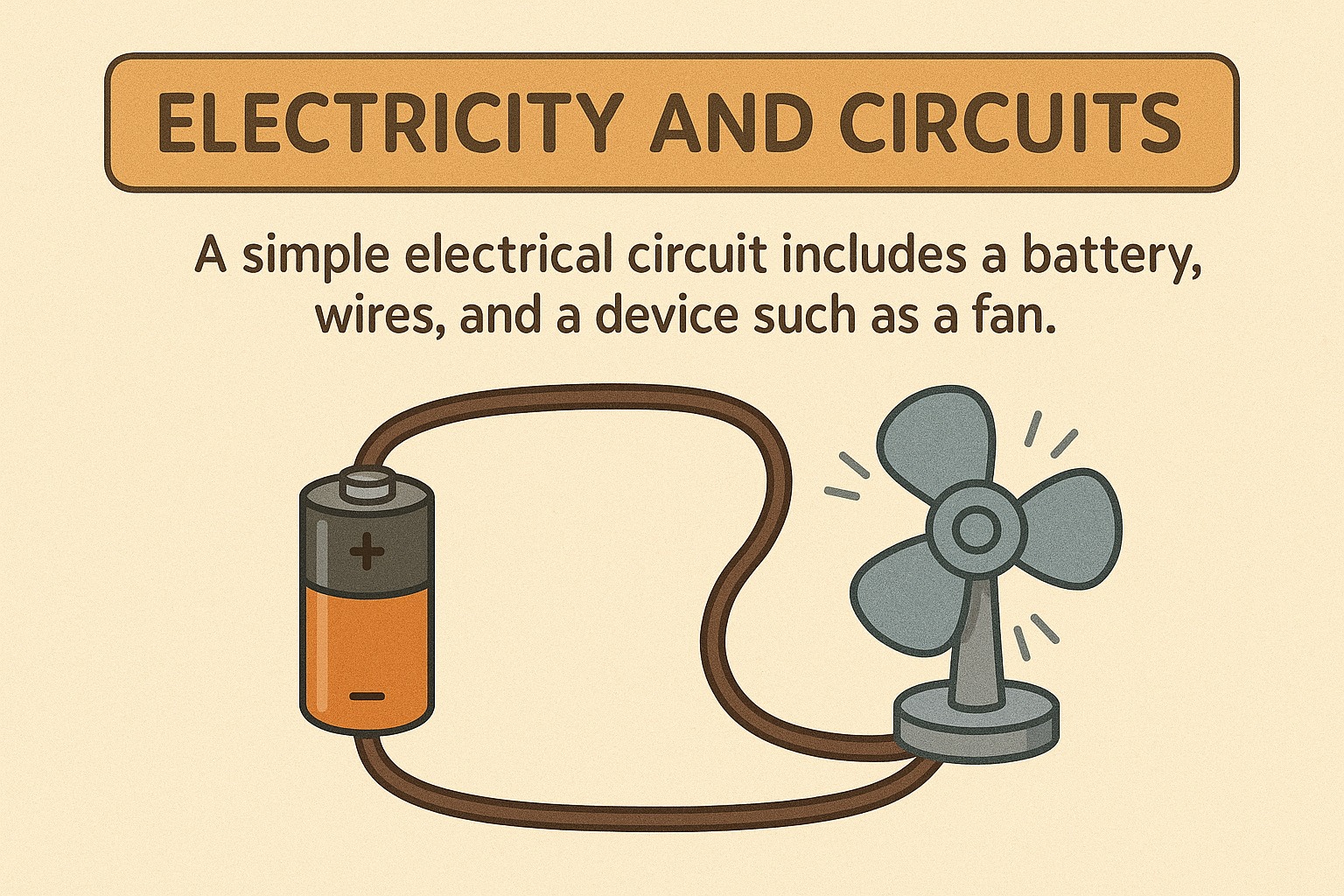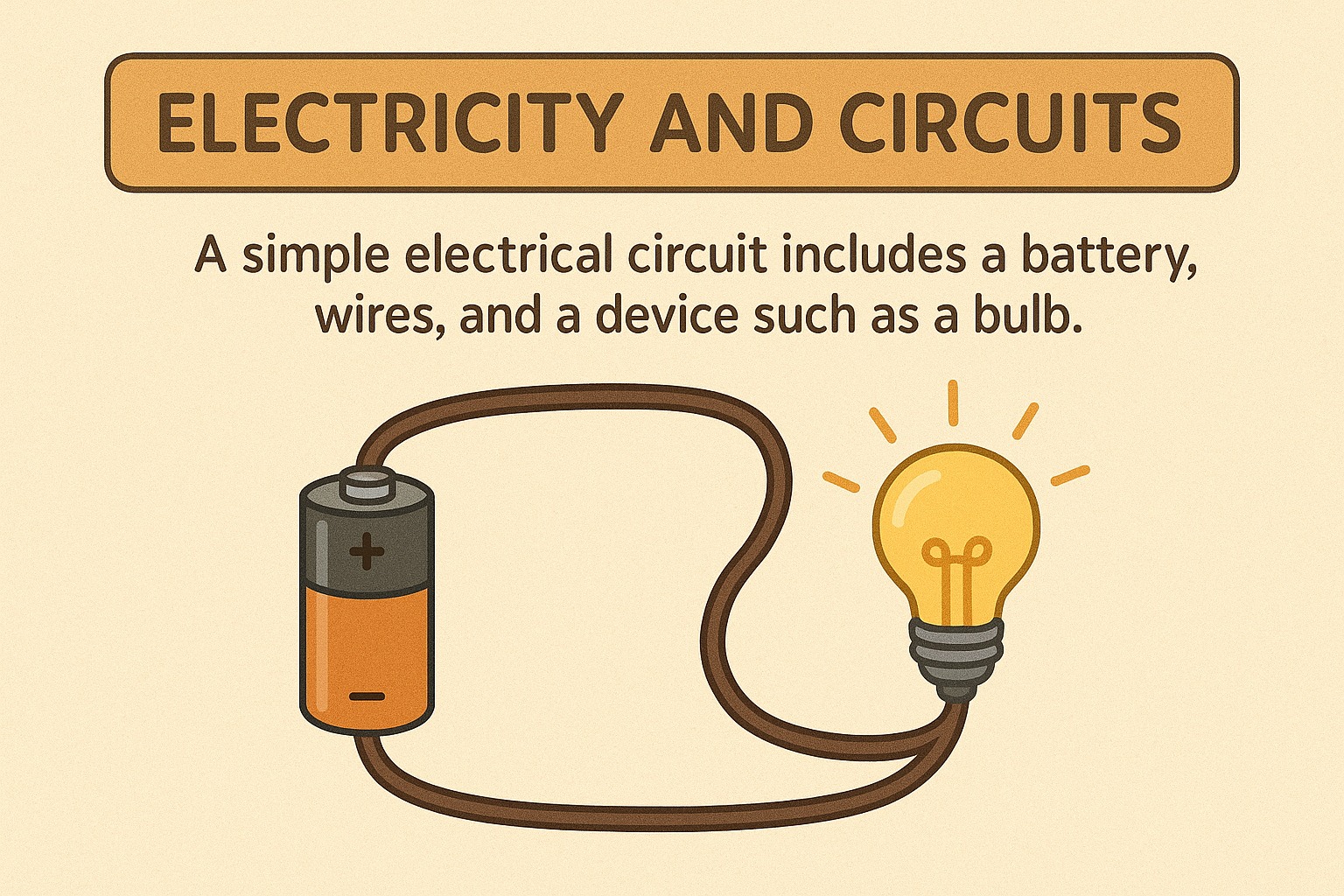Electricity and Circuits
What is Electricity?
Electricity A type of energy created by its charge, electric field & electric potential It is converted into electrical energy for lighting, running a fan, electronics. Electricity is the flow of electrons (small charged particles) moving through a conductor, such as a wire.

Types of Circuits
-
Series Circuit
-
In a series circuit, all electrical components (bulbs, resistors, etc.) are arranged in series. That means the electricity goes through each part in succession.
-
Key Feature: Series circuit - Key Features:If any one of the component fails (bulb burns out), the entire circuit breaks down as the path is opened.
-
Example: Christmas lights are almost always wired in series, meaning that if one bulb fuses, the whole section of lights doesn’t light up.
-
Parallel Circuit
-
Definition: In a parallel circuit, the components are connected across multiple paths. Since each element is directly linked to the source of energy, the current can take several paths at the same time.
-
Key Feature: One thing is not damaged, other things are working Thanks to continuous electrical path.
-
Example: Most household electrical systems are parallel, so if one appliance turns off or goes down, the other appliances will keep working.
Key Components of a Circuit
-
Battery
-
The meaning is that a battery is a power source in a circuit Function It supplies the circuit with the electric power required for its functionality. Every battery comes with 2 terminals which are Positive terminal (+) as well as Negative terminal (-). When the battery is connected to a circuit, electricity can flow from negative to positive terminal.
-
Example: Your battery provides the energy to turn on a light bulb when you start your flashlight.
-
-
Wire
-
Function: Wires carry the current from one part of a circuit to another. It uses copper — a good electrical conductor.
-
Example: The wires linking a bulb to a battery allow electricity to flow from the battery into the bulb & cause it to light up.
-
-
Switch
-
Function: A switch is an electromechanical device that when opened or closed controls the flow of electric current in an electrical circuit. It can open or close the circuit. With a switch open, the circuit is incomplete & current does not flow. The switch now being closed completes the circuit, … and electricity will flow.
-
Example: A light switch in your home opens or closes the circuit to turn the light on or off.
-
-
Bulb

-
Function: It is basically two words that combine to use turn as an energy from electrical/ solar into light energy. Current is then passed through the filament that is inside the bulb that heat up the filament & emit light.
-
Example: An incandescent lightbulb, for example, helps a flashlight convert from battery energy to light, so you can see if the power goes out.
-
-
Resistor
-
Function: Application: A resistor is an element that limits or opposes the flow of electrical current in an electronic circuit. It is responsible for regulating the current & preventing components from receiving excess electricity.
-
Example: A variable resistor, for example, is used to adjust the brightness of light from the bulb by varying the amount of flow through it.
-
Key Concepts in Electricity
-
Current (I)
-
Definition: Electricity Current is the electron flow through a conductor (like a wire). Current, on the other hand, is the flow of electrons, which is measured in amperes (A)
-
Example: This is because turning on a fan allows power to pass down the wires & into the spinning fan motor.
-
Voltage (V)
-
Definition: VVoltage refers to the electrical potential difference present between two locations in a circuit. It is measured in volts (V). Current Voltage is what causes current to flow through a circuit.
-
Example: A battery, for example, applies a voltage, pushing along some electrons through the wire to get a bulb excited.
-
Resistance (R)
-
Definition: Here’s a quick physics refresher to get you started: Resistance is our resistance to the electric flow. It is measured in ohms (Ω). Materials like rubber or plastic are insulators & therefore do not allow commodity of electricity through them. So we know that some materials (copper for instance) have a little resistance under current and therefore are good conductors.
-
Example: A light bulb has a given resistance which results in a specific current going through it, thus giving out a specific amount of light.
-
Ohm’s Law
-
V = I × R (Voltage = Current × Resistance)
-
If you already know two of these values, you can compute the third.
-
V = I × R = 2 A × 5 Ω = 10 V
-
-
Definition: Ohm's Law is like the alphabet of electricity that connects voltage (V), current (I), and resistance (R) in a system. It states that.
-
Example: For a circuit with a 5-ohm resistance & 2–ampere current, you can use Ohm’s Law to determine the voltage.
Descriptive Guide on Electricity and Circuits
A circuit is a complete path that allows electricity to travel. If these three do not form a complete circuit with a power source (like battery), a conductor (like wire) & a load (like bulb), then it cannot function. Circuits in everyday devices fall into two categories:
- Series Circuit: There is one path for the current. The entire system breaks if one part fails.
- Parallel Circuit: Branches for current. If any one part breaks, the others keep functioning.
Electricity and Circuits – Lighting Up Our World!
- Imagine a world without light bulbs, phone chargers, or even video games. Sounds boring, right? That’s why electricity and circuits are super important , they help power almost everything we use every day!
- Electricity is like an invisible energy that flows and brings things to life. But for it to work, it needs a path to travel kind of like a racetrack. That path is called a circuit. When the track is complete, electricity zooms through and powers things like your fairy lights or even your toothbrush!
- Let’s talk about some fun, real-life examples. Ever played with those glowing shoes that light up when you walk? Yup, that’s a tiny circuit inside your shoe doing all the magic. Or think about vending machines - press a button, and out comes your snack. That’s electricity working through a circuit to deliver your treat.
- Even farms use electric fences powered by simple circuits to keep animals safe. Roller coasters? They use electric circuits to start the ride and keep it going at the perfect speed.
- The best part? You can make your own circuits at home with simple science kits. Kids build paper circuits with stickers and coin batteries to light up greeting cards so cool, right?
- Electricity and circuits are all around us. They’re not just about wires and switches , they’re about bringing fun, movement, and light into our lives in creative ways. From automatic doors at malls to your tablet’s touch screen, circuits are working quietly in the background to make life easier and more exciting.
- So next time your toy robot walks or your lamp turns on with a click, remember it’s all thanks to electricity running a clever little race on a circuit!
What is Electricity and Circuits?
Electricity is another form of energy that detects a lot of devices we use every day. It is the movement of electric charge (mostly electrons) through a conductor, like a wire. Circuits are paths that allows electricity to flow, and power devices. A circuit is a complete loop, which gives electrical current a path from the power source (such as a battery) to the device (like a light bulb) & back.
What Are the 4 Types of Electric Circuits?
-
Series Circuit:
- In this configuration, all elements are connected head-to-tail (e.g., bulbs, resistors), creating a single path for the current to flow. If any portion fails, the whole circuit is disrupted.
-
Parallel Circuit:
- Since the components are connected in independent branches, if one of those components fails, the other components can still work normally. This is often seen in household wiring so that if an appliance breaks, the others keep running.
-
Open Circuit:
- A broken path in a circuit so that current cannot flow. That may occur when modern switch is switched off, or when a wire is disconnected.
-
Closed Circuit:
- An unbroken loop allowing charge to travel from the power source, through the components, & back. When a light bulb lights up, or when a fan runs, this is what happens.
Conclusion
- Acids taste sour, like lemon juice or vinegar.
- Bases are bitter and feel slippery, like soap or baking soda.
- Salts are formed when acids and bases neutralize each other.
- The pH scale helps measure whether a substance is acidic, basic, or neutral.
- These concepts are useful in daily life, like in medicine, food, cleaning, and farming.
CBSE Schools In Popular Cities
- CBSE Schools in Bangalore
- CBSE Schools in Mumbai
- CBSE Schools in Pune
- CBSE Schools in Hyderabad
- CBSE Schools in Chennai
- CBSE Schools in Gurgaon
- CBSE Schools in Kolkata
- CBSE Schools in Indore
- CBSE Schools in Sonipat
- CBSE Schools in Delhi
- CBSE Schools in Rohtak
- CBSE Schools in Bhopal
- CBSE Schools in Aurangabad
- CBSE Schools in Jabalpur
- CBSE Schools in Jaipur
- CBSE Schools in Jodhpur
- CBSE Schools in Nagpur
- CBSE Schools in Ahmednagar
- CBSE School In Tumkur











